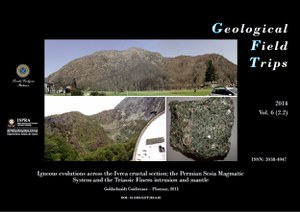Igneous evolutions across the Ivrea crustal section: the Permian Sesia Magmatic System and the Triassic Finero intrusion and mantle
Goldschmidt Conference - Florence, 2013
The famous deep crustal section of the Ivrea-Verbano Zone (western Alps) is one of the best examples of continental “magmatic underplating”. Recent investigations point to the occurrence of a “Sesia-type Zone” (the central area) and a “Finero-type Zone” (the northern area), which underwent different magmatic and tectonic evolution.
In the Sesia area, the Permian gabbroic pluton (the Mafic Complex) intruded the deep crustal section of Southern Alps, composed by paragneiss and interlayered fertile mantle peridotite bodies (lherzolites). The broader magmatic context of this voluminous intrusion remained unclear until it was demonstrated that the emplacement of the Mafic Complex was coeval to a silicic volcanism, including extensive caldera deposits, and to the growth of silicic plutons in the upper crust of the adjacent "Serie dei Laghi". The Sesia Magmatic System constitutes an exposure of the plumbing system of a caldera from the surface to a depth of about 25 km. In this framework, the Mafic Complex records processes occurring in the deep crust beneath the caldera.
The Finero area is characterized by the occurrence of a metasomatised mantle unit made by phlogopite-bearing ultramafic rocks. The mantle unit is surrounded by a layered amphibole-rich mafic-ultramafic intrusion, i.e. the Finero Mafic Complex, which shows different lithological, geochemical, structural and geochronological features with respect to the intrusion in Val Sesia.
Recent U-Pb zircon data point to a Middle-Triassic intrusion age for the Finero Mafic Complex, which can no longer be considered as part of the Permian Mafic Complex exposed in the Sesia area. Instead, U-Pb ages of zircons from massive chromitites of the mantle unit are Lower Jurassic. The marked age span of the Finero Mafic Complex and the associated mantle unit suggests that they experienced different evolutions almost until Lower Jurassic.
This excursion aims to illustrate the nearly complete continental crust section outcropping in the Sesia-type Zone, moving from the deeper crustal sects close to the mantle to the caldera of the supervolcano, and show the different lithological and structural features occurring between the Sesia-type and the Finero-type Zones.
DOI 10.3301/GFT.2014.05

